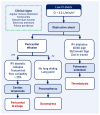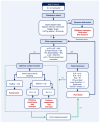Critical Care Ultrasound in Shock: A Comprehensive Review of Ultrasound Protocol for Hemodynamic Assessment in the Intensive Care Unit
- PMID: 39336831
- PMCID: PMC11432640
- DOI: 10.3390/jcm13185344
Critical Care Ultrasound in Shock: A Comprehensive Review of Ultrasound Protocol for Hemodynamic Assessment in the Intensive Care Unit
Abstract
Shock is a life-threatening condition that requires prompt recognition and treatment to prevent organ failure. In the intensive care unit, shock is a common presentation, and its management is challenging. Critical care ultrasound has emerged as a reliable and reproducible tool in diagnosing and classifying shock. This comprehensive review proposes an ultrasound-based protocol for the hemodynamic assessment of shock to guide its management in the ICU. The protocol classifies shock as either low or high cardiac index and differentiates obstructive, hypovolemic, cardiogenic, and distributive etiologies. In distributive shock, the protocol proposes a hemodynamic-based approach that considers the presence of dynamic obstruction, fluid responsiveness, fluid tolerance, and ventriculo-arterial coupling. The protocol gives value to quantitative measures based on critical care ultrasound to guide hemodynamic management. Using critical care ultrasound for a comprehensive hemodynamic assessment can help clinicians diagnose the etiology of shock and define the appropriate treatment while monitoring the response. The protocol's use in the ICU can facilitate prompt recognition, diagnosis, and management of shock, ultimately improving patient outcomes.
Keywords: cardiac output; fluid responsiveness; hemodynamic monitoring; hemodynamic shock; point-of-care ultrasound; ventriculo-arterial coupling.
Conflict of interest statement
The authors declare no conflicts of interest.
Figures




References
-
- Evans L., Rhodes A., Alhazzani W., Antonelli M., Coopersmith C.M., French C., Machado F.R., Mcintyre L., Ostermann M., Prescott H.C., et al. Surviving Sepsis Campaign: International Guidelines for Management of Sepsis and Septic Shock 2021. Crit. Care Med. 2021;49:E1063–E1143. doi: 10.1097/CCM.0000000000005337. - DOI - PubMed
Publication types
LinkOut - more resources
Full Text Sources

